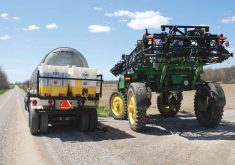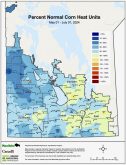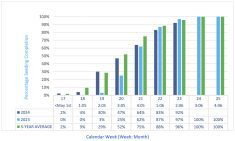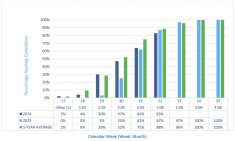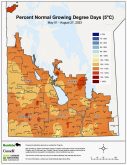Overview
Reports of waterhemp showing up in soybean fields in the RM of Emerson-Franklin and in the RM of DeSalaberry. Producers are encouraged to scout for this weed and remove from fields when found. For more information please see the Manitoba Crop Pest Update July 19 edition.
Winter cereal crops continued to dry down over the last week with producers applying pre-harvest herbicides or swathing as crop seed moisture content allowed. Swathing has begun in the Carman region in the earliest fall rye fields. In other regions if the weather is conducive to continued drydown, harvesting will begin within the next seven days. Crop condition remained good to excellent.
Read Also

Predicting Manitoba winter snowfall
How much snow should farmers in Manitoba expect for the rest of December 2025 and into January-February 2026? Here’s what the weather models say about the winter to come.
Canola crops across the province are mostly at 70 per cent flower to pod filling. However, late seeded canola in the Northwest region has just recently bolted and entered the flowering stage. Overall crop condition ranged from fair to mostly good. Sunflower fields were mostly in the R4 growth stage and moving quickly to R5 stage. Over the past week the crop has continued to demonstrate rapid growth and remained in good to excellent condition.
Cereals
Winter cereal crops continued to dry down over the last week with producers applying pre-harvest herbicides or swathing as crop seed moisture content allowed. If the weather is conducive to continued drydown, harvesting will begin within the next seven days. Crop condition remained good to excellent.
Spring wheat crops were showing some evidence of turning and colour change. Overall, cereal crops remain in fair to mostly good condition. Although some oat fields seeded on light soils and in lower rainfall areas were starting to show stress symptoms, most notably turning white and rapidly drying down.
In the Central region near Carman both spring wheat and oats have seen fields rapidly dry down due to the lack of moisture. Spring wheat in these areas could be harvested in the next week to ten days.
Corn fields were in the R1 (silk) growth stage. The crop remained in good to excellent condition and demonstrated rapid growth once the warmer weather returned.
The spring wheat crop is rated mostly fair to good.
Oilseeds
Most of the canola crop in the region ranged from 70 per cent flower to pod filling. Overall crop condition ranged from fair to mostly good and the past cool weather did extend flowering on some crops. Flowering is expected to wrap up quickly with the return to seasonal temperatures.
Sunflower fields were mostly in the R4 growth stage (inflorescence beginning to open) but noted as moving quickly to R5 (flowering). Over the past week the crop continued to demonstrate rapid growth and remained in good to excellent condition.
Flax crops continued at growth stage 9 (late flower). The previous cool weather facilitated continued flowering but the return to more seasonal weather saw flower drop accelerate. The crop was mostly in good condition overall but, in drier areas, some crops in fair condition could be found.
Pulses and soybeans
Field pea crops were well into the R5 (beginning maturity) growth stage last week and are expected to move rapidly to maturity if the weather is conducive.
Soybean fields were at the mid R4 (full pod) growth stage with late seeded fields at the late R3 (beginning pod) growth stage. Overall crop condition remained good on most fields with the exception of some later seeded crop that remained stagey and thin due to poor topsoil moisture conditions at seeding time.
Dry beans are flowering and pod development has begun. Fungicide application has continued on dry bean fields where potential for disease is higher.
Forages and livestock
Forages
Haying continued between scattered rain showers in the Eastern region last week. Second cut is well underway for dairy producers and, in general, yields are reported as below average.
The majority of beef producers are close to completing first cut with some grass and native hay fields remaining. A handful of beef producers have started second cut and many plan to work on harvesting their greenfeed acres this week. Yields remain highly variable and are dependent on moisture conditions.
Regrowth on hayfields is slow and thin. Grass conditions on pasture are fair, but more moisture is needed, particularly on pastures with lighter soils. Right now second cut does not look good and in most areas there will probably not be a second cut unless we see a rain.
Wild hay and grass harvest continues with second cut beginning in fields where there was sufficient moisture for regrowth. In most cases second cut of hay will be limited.
Livestock
Water levels in dugouts are low and water supply may become a very serious concern in the near future. Dugouts are about 50 per cent full in the Southwest region and at sufficient levels in the Interlake region.
Heavy levels of flies has resulted in cattle being treated for pink eye.
Lots of hayfields and some pastures are going dormant.
Pastures that haven’t been overgrazed in the past and have the appropriate stocking density are keeping up with cattle feed demand but regrowth will be reduced in areas where there is a lack of moisture.
Pastures are average to below average condition and are in need of moisture. Producers in some areas
have been spraying pastures for grasshoppers.
Regional comments
Southwest
Another dry week in the southwest with no significant moisture and warmer temperatures have started to show effects on crops in some areas especially those areas that are in desperate need of precipitation. Some areas are losing tillers and starting to ripen or turn prematurely. Forecast this week for hotter temperatures will only increase the amount of damage in the fields. Any precipitation is welcome and most areas in the region remain short for moisture. In general, crops look average now; however, with little to no rainfall this week the area has gotten larger.
Fall rye and winter wheat range from hard dough to turning and in some areas are about a week away from harvest. In most fields a rain would not make a big difference at this time. Still reports of some grasshoppers damaging the crops as they move from dried pastures and hayland into crops. Wheat and barley are in the soft dough stage. Some of the early seeded crops or areas where moisture is needed are starting to turn. Several fields have areas showing drought stress with white spots showing up. Oats are in the milk stage.
Most corn has silked. Crop has managed the dry conditions well, however light sandy soils without rainfall are showing severe signs of stress.
Pea crops are in pod fill stage. Some later sown fields are still flowering and some of the early planted fields are full pod stage. Dry conditions have helped with very little to no disease issues.
Most canola crops are in full flower with the early seeded crops podding and going out of bloom. Crop is starting to show drought stress as areas in fields are aborting flowers. No major insect concerns as of yet but producers are watching fields. Starting to show blasting in some areas.
Soybeans are at R3 to R4 stage. Crops look fair and are in need of rain at this point. Some late weed growth in areas where the stands are thin.
Northwest
Another mixed week of weather with warm temperatures near normal for July; however, nighttime temperatures still cooling into the single digits. Localized showers brought precipitation to some areas. Precipitation amounts continue to vary greatly across the region. Some areas seeing heavy dews in the morning. A couple of days saw smoky conditions due to wildfire.
Bertha armworm trap counts remain low across the Northwest region. The highest counts are Durban with 122 and The Pas with 219. Both counts still remain below threshold levels. Grasshopper pressure continues with dry conditions, especially in the Dauphin/Fork River area.
Fall rye and winter wheat continue in the dough stages getting closer to maturity. Some pre-harvest applications have been done in the Dauphin area. Some ryegrass harvest has begun in the Fork River area.
Spring cereals continue to progress from the milk stage and are moving into the late milk/soft dough stage. Most spring cereals are in good condition; however, some areas would have greatly benefited from precipitation.
Canola continues in various stages across the region due to the wide range of seeding dates and emergence. Some of the earliest seeded canola in the Swan River region is at end of flowering and podded, while the later seeded crops have recently bolted and are just beginning the flowering stage.
Field peas are in the R4 and starting R5 growth stage. There are areas in the fields that were stressed through the season that appear yellow. Field peas are mostly in good condition except those that did not receive adequate precipitation and are short.
Soybeans are mostly at the R2 and now into R3 stage across the region. For the most part they look good, but in some areas that haven’t got adequate moisture they appear short. Some areas continue to see grasshopper activity picking up.
Central
The week was dry for most locations in the central region. Most producers would appreciate an inch or two of rain, especially soybean and corn producers and those with hay and pasture. Cooler weather last week was beneficial for crops flowering and grain filling. The weather this year has resulted in crops approaching harvest earlier than normal. Over the coming week fall rye and winter wheat will continue to be swathed and harvested, and it is likely early spring wheat, oats, and peas will begin to be combined as well.
Aphids have been observed in soybean and cereals, at times above threshold levels, with some farmers applying insecticide in fields of soybean and spring wheat. Grasshoppers are high in localized areas, feeding on cereals, pasture and some soybean and dry bean fields. Some armyworms have been observed and sprayed. Producers have observed armyworm being parasitized by beneficial insects. Fungicide applications where producers deemed them necessary are mostly complete, but some dry beans are still receiving applications.
Most cereals are visibly drying down. Fall rye and winter wheat is at soft to hard dough stages, with some fields being swathed. Most winter cereals will be harvested within one to two weeks. Spring wheat and barley are at the soft dough to hard dough stages and quickly approaching harvest. Oats are between the milk to the hard dough stages. Corn is tasseling, with the early ears forming and some silking.
Most sunflowers are at the flowering stage (R5), or just about to approach flowering.
Field peas are at the end of flower and pod filling. Some peas are close to dry down in the most advanced fields. Flax is at the end of flower, with bolls filling. Soybean and dry beans are flowering with pods forming, between R2 to R5, with most around R4.
Eastern
Across the Eastern region, accumulated rainfall over the reporting period varied from trace amounts to as much as 30 mm most often occurring as fast moving showers or thunderstorms. Overall, the greatest amounts of rainfall occurred on Wednesday of last week although precipitation events happened somewhere every day. There were also reports of occasional hailstorms although these tended to be localized and less damaging than events seen during the previous week. Day and night time temperatures continued below seasonal during the start of last week but trended to normal levels by the weekend. This brought an end to the cooler than normal period experienced over the previous two weeks. While crops remain in good condition overall, soil moisture reserves are not adequate to maintain crop condition over the coming weeks unless significantly recharged.
Winter cereal crops continued to dry down over the last week with producers applying pre-harvest herbicides or swathing as crop seed moisture content allowed. If the weather is conducive to continued drydown, harvesting will begin within the next seven days. Crop condition remained good to excellent.
Spring cereal growth stage ranged from soft to hard dough with the exception of very late seeded crops that were in late milk. Very early seeded crop put on light land in low rainfall areas began to dry down and harvest was expected in early August. Compared to last week, many spring wheat crops were showing some evidence of turning and colour change. Overall, cereal crops remain in fair to mostly good condition although some oat fields seeded on light soils and in lower rainfall areas were starting to show stress symptoms, most notably turning white and rapidly drying down. Insect scouting continued in the crop for armyworms and grasshoppers but only limited insecticide applications occurred.
Most corn fields were somewhere in the R1 (silk) growth stage. The crop remained in good to excellent condition and demonstrated rapid growth once the warmer weather returned. Many producers hope that the past cool weather during tasseling and silking along with recent rainfall in some areas would be supportive to yield. Very low levels of suspected Goss’s Wilt symptoms were noted on some crops. Disease and insect scouting intensified as crops moved into reproductive growth stages, although no concerns were identified thus far.
Sunflower fields were mostly in the R4 growth stage (inflorescence beginning to open) but noted as moving quickly to R5 (flowering). Over the past week the crop continued to demonstrate rapid growth and remained in good to excellent condition. Scouting for insects continued although no concerns were identified thus far.
Most of the canola crop in the region ranged from 70 per cent flower to pod filling. Overall crop condition ranged from fair to mostly good and the past cool weather did extend flowering on some crops. Flowering is expected to wrap up quickly with the return to seasonal temperatures. Fungicide applications were completed. Insect scouting continued with diamond back moth larvae and lygus bugs being found at below threshold levels. Only a very limited amount of spraying has occurred and scouting continues.
Flax crops continued at growth stage 9 (late flower). The previous cool weather facilitated continued flowering but the return to more seasonal weather saw flower drop accelerate. The crop was mostly in good condition overall but, in drier areas, some crops in fair condition could be found.
Most soybean fields were at the mid R4 (full pod) growth stage with late seeded fields at the late R3 (beginning pod) growth stage. Overall crop condition remained good on most fields with the exception of some later seeded crop that remained stagey and thin due to poor topsoil moisture conditions at seeding time. Insect scouting, particularly for soybean aphids, green cloverworm and grasshoppers, continued. On some fields, increased soybean aphid numbers were noted although these populations were still below threshold levels and often in “hotspots” within fields.
Interlake
Crop development continues with warm weather, spotty rain and high humidity. Temperatures ranged from 11.2- 17.6 C , with average temperatures slightly lower than the previous week. Rainfall continues to be variable with scattered thundershowers. Rainfall received this past week ranged from 1 to 5.5 mm across the Interlake region. Amounts over the weekend ranged from 1 to 7 mm for Fisherton, Moosehorn, Woodlands, Poplarfield and Arborg. Taylors Point had about 8 mm with no rain at all in the Riverton area. The rain that was received contributed significantly to flowering and crop advancement. Although improvement continues, much of the region continues to have lower than normal amounts of precipitation.
Crops are generally looking very good. Warm temperatures and good moisture have allowed for rapid crop growth. Cereals are looking great, other than some of the last seeded or reseeded fields; heads have now emerged. Spring wheat and barley have set seed and are starting to fill, as are oats. Most of the lodged cereals have come back up over the last week. Spring wheat is fully headed and are at the soft dough stage. Fall rye has turned colour and nearing maturity soon. Fall rye pre-harvest glyphosate will be starting in the coming weeks.
Peas look excellent. They are flowering and pods are filling well. Peas seeded on the drier fields have smaller pods and seeds, but potential yields might still be good. Most peas are at R3 to late R4. Fababeans are looking good and flowering will soon be complete.
Some canola fields look great with a nice even stand, whereas others are thin and stagey due to a number of earlier stresses like flea beetle damage, wind, crusting and poor germination in dry conditions. Some fields have been reseeded twice. Staging canola is difficult due to the number of reseeded fields. The earliest seeded fields are fully podded but a number are still flowering. The earliest seeded fields are fully podded while late seeded fields are in full bloom.
Soybeans continue to advance. Rows are filling in even though stands look shorter than normal. Flowering continues and most fields are R3 to early R4, with pods forming at the bottom of plants.
There have been reports of armyworms in a number of fields including perennial ryegrass, fescue, timothy, spring cereals and hay fields requiring insecticide treatment. Fields continue to be monitored, with most reporting numbers currently below threshold. No insect spraying was reported this past week. Regular scouting has managed to keep additional damage in check.
Increasing numbers of grasshopper hotspots are being reported in some parts of the region, and fields are being monitored carefully. Grasshopper activity has been found on cereal crops and around edges of the field. Diamondback moth larvae can be found in canola, but crop growth is sufficient that significant damage should not be a concern with the first generation of larvae. Bertha armyworm moth trap counts have increased, but total numbers continue to be low. There has been a report of low armyworm count across the Interlake region.




